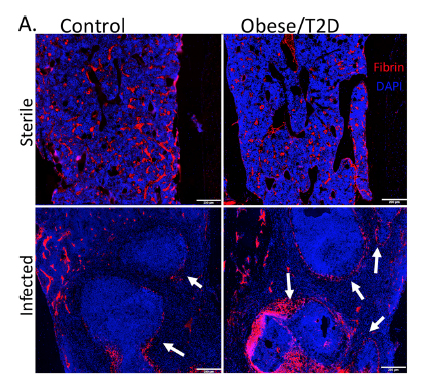Impact of obesity and type 2 diabetes on Staph aureus bone infection severity
Obese patients have up to a 5-fold increase in susceptibility to orthopaedic metal implant-associated S. aureus surgical infections. Only by understanding the factors contributing to this increased risk will it be possible to design effective therapeutic approaches. Using our mouse model of implant-associated S. aureus osteomyelitis in the background of obesity, we have developed compelling evidence that the hypercoagulable state of obesity that promotes fibrin deposition is critical to the increased virulence of S. aureus in the obese host.

Remarkably, we also report that S. aureus in the obese host markedly increases selective expression of four microbial surface component recognizing adhesive matrix molecules (MSCRAMMs) of the Clf-Sdr family that have fibrin(ogen) as their ligand. These genes include clumping factor A (clfA, 34 fold increased in obese vs. lean infected mice), clumping factor B (clfB, 19 fold), surface anchored protein (sdrC, 47 fold), and bone sialoprotein-binding protein (bbp, 5 fold).These apparently rapid adaptations would predictably increase the survivability of the invading pathogen in the obese host by facilitating aggregation of the organism into the immuno-protective environment of developing fibrin-containing biofilm on the metal implant surface and early fibrin-encapsulated abscesses in soft tissue and bone marrow space.
Future objectives are to more completely understand the Staph aureus-obese host interactions and adaptations that mediate increased infection severity and to develop potentially new therapeutic strategies that target this unique interaction.
Above: Increased fibrin formation in obese/T2D mice. Control and obese/T2D mice received a S. aureus-infected transtibial pin. At 14d, mice were sacrificed, tibiae isolated, sectioned, and stained for fibrin/counterstained with DAPI. White arrows indicate increased fibrin deposition around abscesses in obese/T2D mice. The unstained area immediately adjacent to the staining is cortical bone (black area).